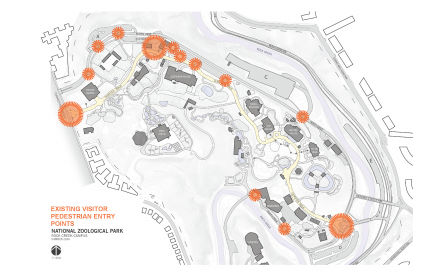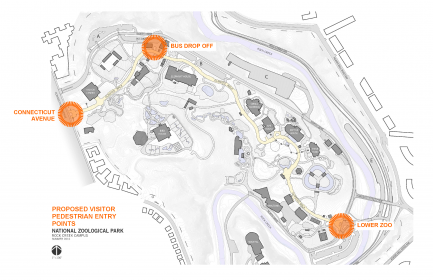Statement on National Zoo Security-Access Plan
The safety and security of the visitors, staff and animals are the No. 1 priority at the Smithsonian’s National Zoo. The Zoo has an existing perimeter that currently has 13 pedestrian entrances. To improve the Zoo’s overall security and visitor experience, the number of pedestrian entrances will be decreased to three—Connecticut Avenue, the lower Zoo (Harvard Street) and the bus parking area near giant panda habitat. These are the three entrances that the vast majority of visitors use now.
Limiting the number of ways people enter the Zoo will enhance security and safety year-round. For the past four years during high visitation days or when there has been an increased threat level, security at these entrances has included bag checks and additional screening. The Zoo will continue this practice. On most days, visitors will use these three entrances as they do now.
The only part of the Visitor Access and Security Fencing Project proposal put forward to the National Capital Planning Commission (NCPC) for approval is the installation of additional fencing, which will begin in 2019. Although the proposal before NCPC refers to additional phased security concepts, these proposals are not under review by NCPC at this time. The Smithsonian is committed to engaging in a public process before submitting new security concepts for review by NCPC. Comments can be submitted to the Smithsonian via NZP-CommunityOutreach@si.edu.
Security-Access Plan FAQs:
The safety and security of our visitors, staff, volunteers and animals are the No. 1 priority at the Smithsonian.
Will I go through bag searches every time I go to the Zoo?
Not in the immediate future. However, we anticipate that during high-visitation periods or when there is an increased threat level, security at these entrances will include bag checks and additional screening as needed. This is in line with what the Zoo has done for the past four years.
The Zoo is reducing the pedestrian entrances from 13 to three. Where are the three entrances?
The vast majority of visitors enter the through the Connecticut Avenue entrance, the lower Zoo (near Harvard Street) and the bus parking area near giant panda habitat. These will be the three access points that remain open to pedestrians. Check out this visual rendering of the Zoo’s current pedestrian entrances and the three future entrances. Click here to see a current Zoo map.
How will reducing the number of entrances make the Zoo safer? Limiting the number of ways people enter the Zoo will enhance security and safety year-round. In the past four years on a temporary basis, the Zoo has successfully reduced its pedestrian entrances down to three.
Will the perimeter fence impact the current bike path that crosses the Zoo’s property?
No.
Will there be long wait times to enter the Zoo?
On a typical day, visitors should not experience delays entering the Zoo. Visitors may experience a short delay if there is enhanced security screening.
Can you clarify what the Smithsonian is asking of National Capital Planning Commission (NCPC)?
The only part of the Visitor Access and Security Fencing Project proposal put forward to the NCPC for approval is the installation of additional perimeter fencing. The proposal before NCPC included Phase 2 and 3 concepts, which are not being put forward for approval at this time. The Smithsonian will engage in a public process before putting forward any other component of this plan before NCPC.
May I read the proposal?
Yes. The documents submitted are available on the NCPC website: https://www.ncpc.gov/files/projects/2018/7986_National_Zoological_Park_Supplemental_Perimeter_Fencing_Submission_Materials_Jul2018.pdf.
How much fencing is being added? Where will it change the look and feel of the park like setting of the Zoo?
There will be approximately 4,700 linear feet of fencing that will supplement existing perimeter and animal-containment fencing already installed at the Zoo. Ornamental black fencing will be used in public areas. The majority of fencing will be added internally on Zoo property along North Road (used by drivers to pass through the Zoo) and around the existing parking lots.
The Zoo is an outdoor park that is not like any other Smithsonian museum. Was this taken into account when the Smithsonian developed this proposal?
Yes. There is no one-size-fits-all approach to security at the Smithsonian. The Zoo’s 163-acre grounds do not have defined entrances and exits found in buildings. The Smithsonian took the unique footprint of the Zoo into account. Based on implementing security-access points for the past four years during high-visitation periods, narrowing 13 entrances to three is the most responsible and efficient way for the Zoo to enhance security and safety year-round.
What is the timeline for this project?
Phase 1, which covers the additional fencing, will start construction in 2019.
Will vehicle entrances for the public change?
No. Vehicles will be able to enter the Zoo from the Connecticut Avenue vehicle entrance, Harvard Street bridge and Rock Creek Park.
What security measures does the Zoo have in place now?
The Zoo has a comprehensive approach to security that includes measures that are visible and others that are not. We do not broadly discuss the specifics of our security procedures to avoid compromising their effectiveness.
Once parked at the Zoo, will visitors, especially those pushing strollers or with small children, have to walk a long way to get to one of the three access points?
No. As part of this process, the Zoo will make sure that a safe path to each access point is clearly marked and accessible to all visitors.
How will the installation of the fencing impact the surrounding neighborhood?
We do not anticipate that the installation of the additional fencing will impact the neighborhood.
As part of the Smithsonian, will the Zoo begin selling tickets to enter?
No. The Zoo will remain free to the public. For more information about visiting the Zoo, see the Visit section of the Zoo’s website.
Will this change what I can currently bring to the Zoo during my visit?
No. The Zoo has a few rules to help ensure an enjoyable and safe experience for all visitors. For more information, see the “Park Rules” section of the Zoo’s website as well as the Smithsonian’s security policies.
# # #
SI-408-2018
Linda St. Thomas
202-841-2517



